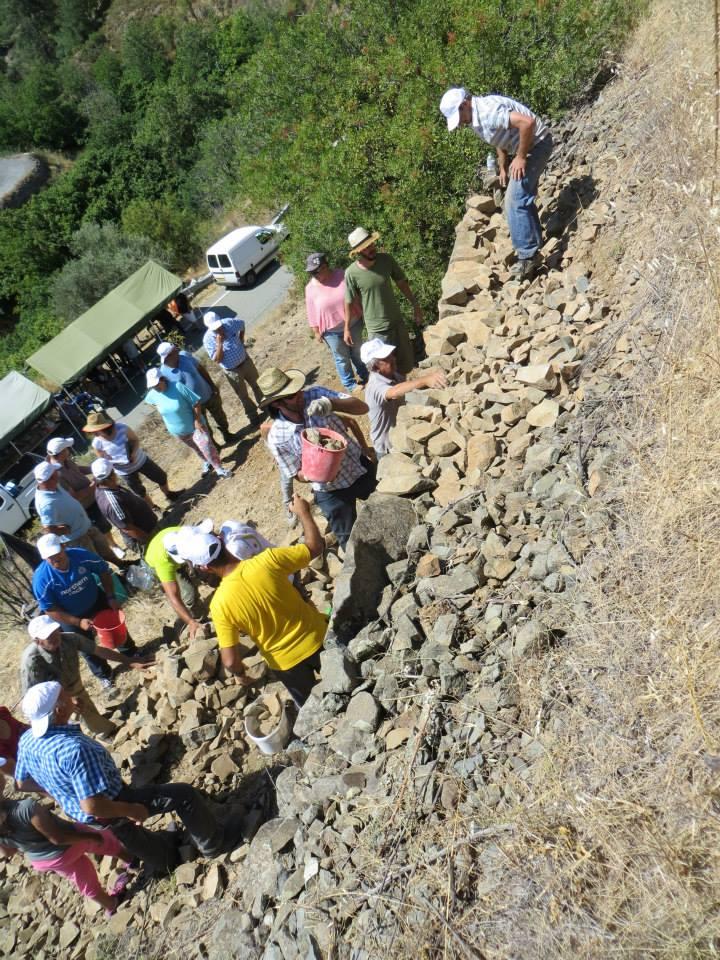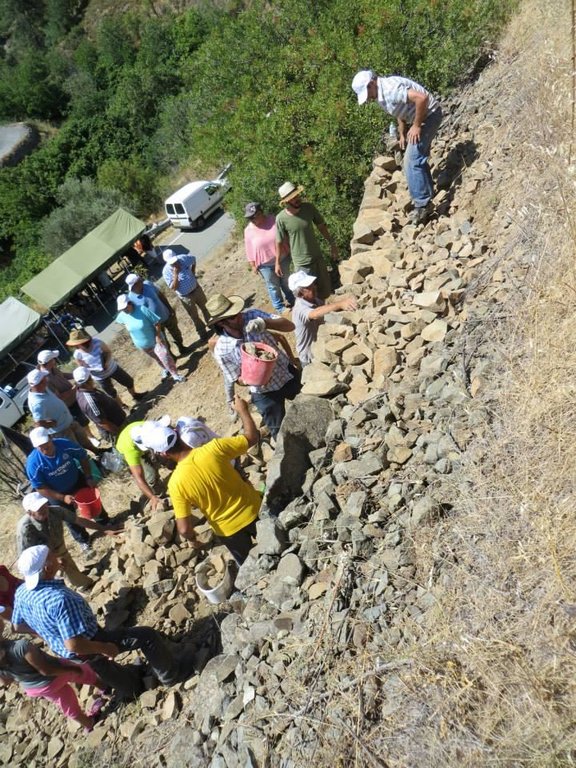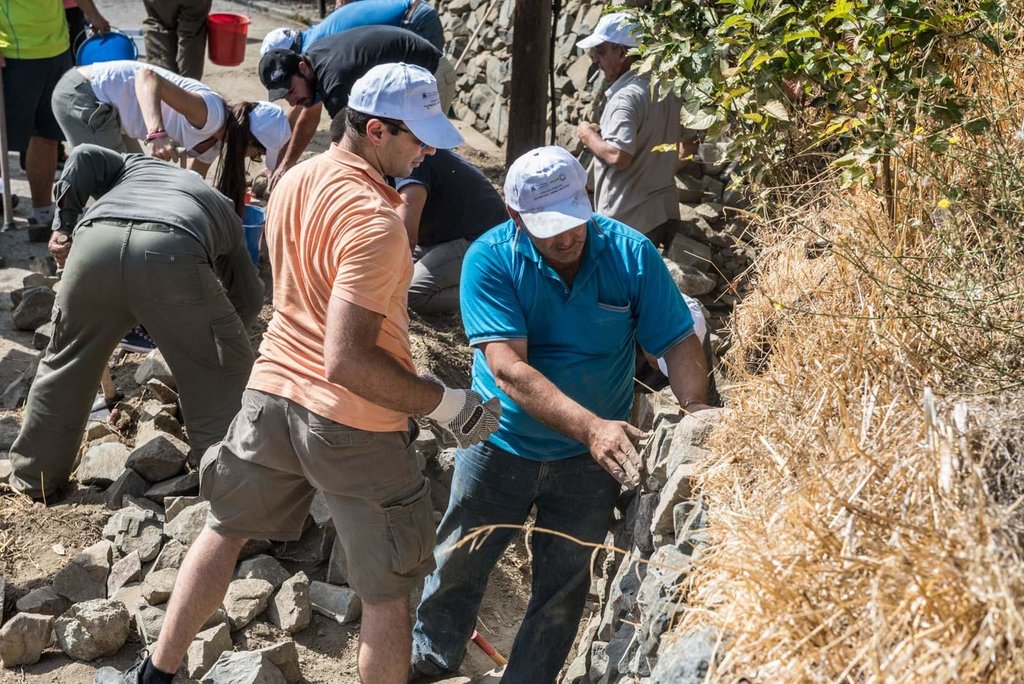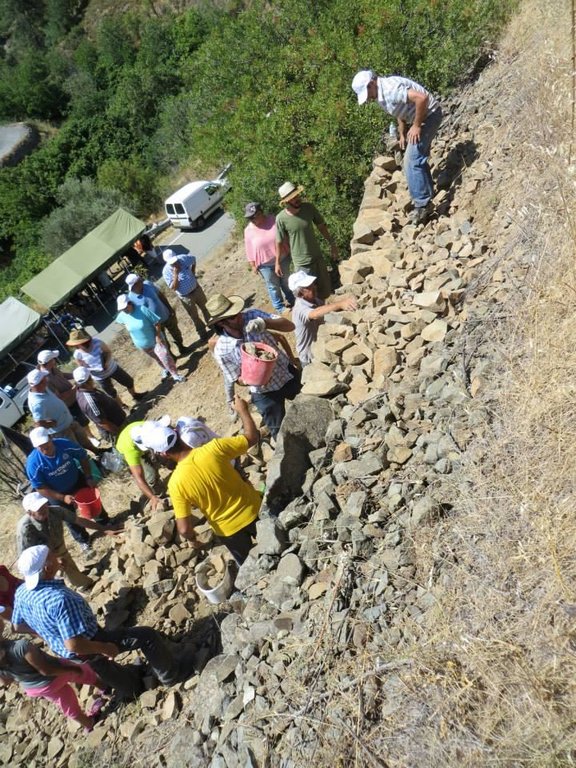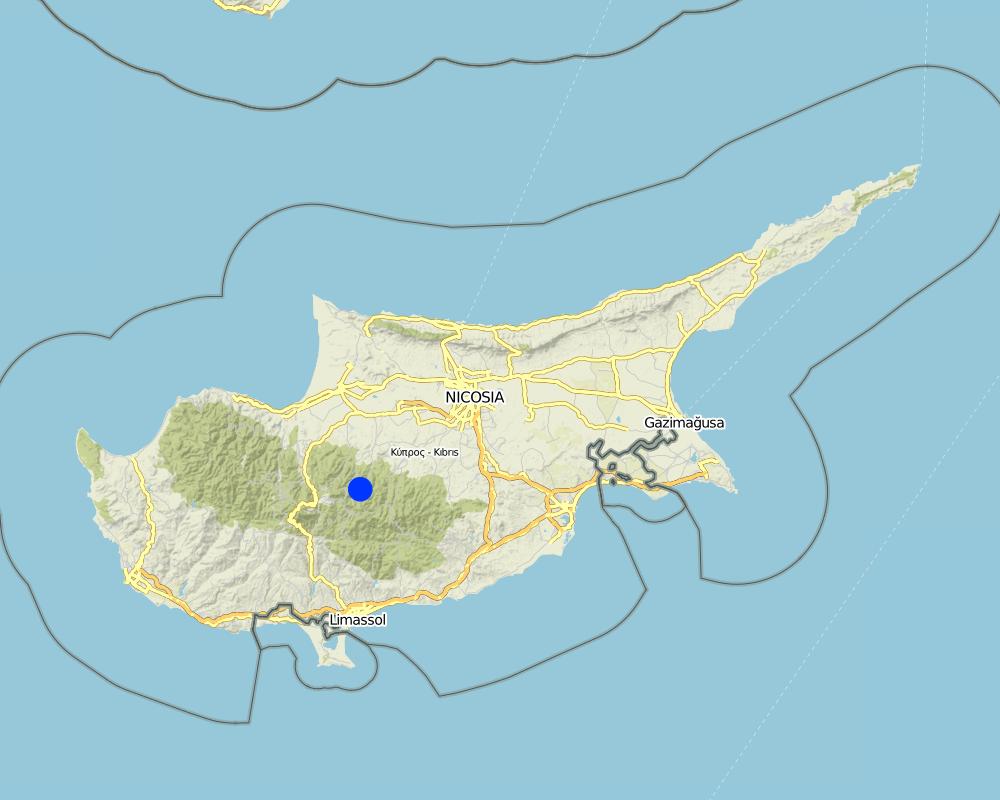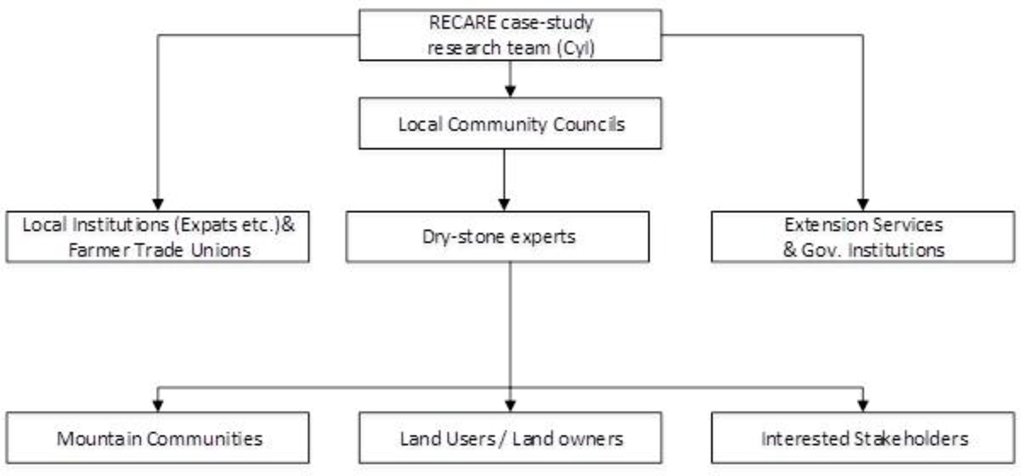Community-based maintenance and rehabilitation of agricultural terraces in mountain environments [ຊີປຣັດ]
- ການສ້າງ:
- ປັບປູງ:
- ຜູ້ສັງລວມຂໍ້ມູນ: Christos Zoumides
- ບັນນາທິການ: –
- ຜູ້ທົບທວນຄືນ: Fabian Ottiger
Κοινοτική συμμέτοχη για συντήρηση και αποκατάσταση ορεινών γεωργικών αναβαθμίδων (Greek)
approaches_2537 - ຊີປຣັດ
ເບິ່ງພາກສ່ວນ
ຂະຫຍາຍທັງໝົດ ຍຸບທັງໝົດ1. ຂໍ້ມູນທົ່ວໄປ
1.2 ລາຍລະອຽດ ການຕິດຕໍ່ ຂອງບຸກຄົນທີ່ຊັບພະຍາກອນ ແລະ ສະຖາບັນ ການມີສ່ວນຮ່ວມ ໃນການປະເມີນຜົນ ແລະ ເອກະສານ ຂອງວິທີທາງ
ຜູ້ຊ່ຽວຊານ ດ້ານການຄຸ້ມຄອງ ທີ່ດິນແບບຍືນຍົງ:
Burggemann Adriana
The Cyprus Institute
Nicosia
ຊີປຣັດ
ຊື່ຂອງໂຄງການ ທີ່ອໍານວຍຄວາມສະດວກ ໃນການສ້າງເອກກະສານ ຫຼື ປະເມີນດ້ານແນວທາງ (ຖ້າກ່ຽວຂ້ອງ)
Preventing and Remediating degradation of soils in Europe through Land Care (EU-RECARE )ຊື່ຂອງ ສະຖາບັນການຈັດຕັ້ງ ທີ່ອໍານວຍຄວາມສະດວກ ໃນການສ້າງເອກກະສານ ຫຼື ປະເມີນແນວທາງ (ຖ້າກ່ຽວຂ້ອງ)
The Cyprus Institute (The Cyprus Institute) - ຊີປຣັດ1.3 ເງື່ອນໄຂ ຂອງການນໍາໃຊ້ເອກກະສານຂໍ້ມູນ ຂອງ WOCAT
ເມື່ອໃດທີ່ໄດ້ສັງລວມຂໍ້ມູນ (ຢູ່ພາກສະໜາມ)?
01/09/2015
ຜູ້ສັງລວມ ແລະ ບັນດາຜູ້ຕອບແບບສອບຖາມ ຍອມຮັບໃນເງື່ອນໄຂ ການນໍາໃຊ້ຂໍ້ມູນເອກະສານ ທີ່ສ້າງຂື້ນ ໂດຍຜ່ານ ອົງການ WOCAT:
ແມ່ນ
1.4 ເອກະສານອ້າງອີງ (ຫຼາຍ) ກັບແບບສອບຖາມ (ຫຼາຍ) ເຕັກໂນໂລຢີ ຂອງດ້ານການຄຸ້ມຄອງ ດິນແບບຍືນຍົງ
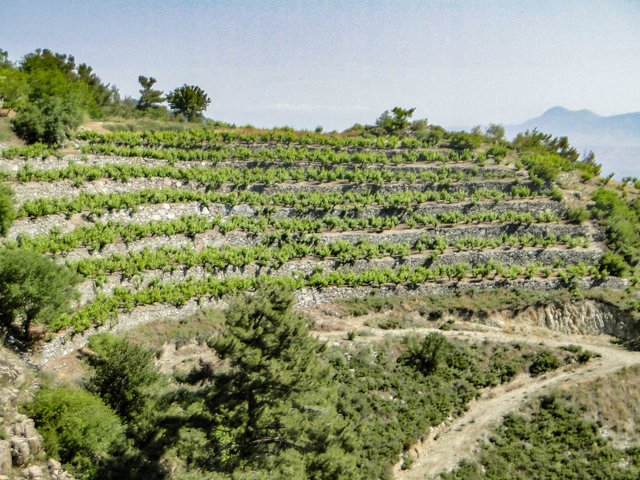
Agricultural terraces with dry-stone walls [ຊີປຣັດ]
Dry-stone terraces built to create agricultural land, minimise soil erosion and retain soil moisture on steep mountain slopes.
- ຜູ້ສັງລວມຂໍ້ມູນ: Christos Zoumides
2. ພັນລະນາ ແນວທາງການຄຸ້ມຄອງນໍາໃຊ້ດິນແບບຍືນຍົງ
2.1 ການອະທິບາຍ ໂດຍຫຍໍ້ ຂອງວິທີທາງ
Maintenance and rehabilitation of traditional dry-stone terrace walls for agricultural use, through science-society cooperation, community engagement and motivation, and assistance to land users.
2.2 ການອະທິບາຍ ລາຍລະອຽດ ຂອງວິທີທາງ
ການອະທິບາຍ ລາຍລະອຽດ ຂອງວິທີທາງ:
Aims / objectives: The main objective of the approach is the restoration and rehabilitation of traditional dry-stone terraces in Mediterranean mountain environments. Large areas around mountain communities have been converted to agricultural terraces. The depopulation of these rural mountain communities and the high farming costs have led to the gradual reduction of farming activities. Consequently, many of the mountain terraces are no longer cultivated and dry-stone walls are not well maintained, causing a domino effect of collapsing terraces. Soil erosion by water has been identified as the main soil threat in degraded and poorly vegetated terraces.
The approach has been developed by the Cyprus Institute research team and aims at motivating the mountain communities, land users/owners, local institutions and other interested stakeholders to better organise themselves and collaborate and join forces in maintaining these terraces.
Methods: The approach is based on participatory principles. More precisely, the science-society cooperation approach is materialised through the organization of practical (hands-on) public events, where dry-stone experts guide the participants, land users/owners, local population, expats (families that have moved to the urban areas) and scientific stakeholders, in collectively maintaining collapsed and/or poorly maintained terraces. All parties engaged in the implementation of the approach on voluntary basis.
Stages of implementation: A pool of local and external stakeholders was prepared by the research team using snowball sampling. Key stakeholders identified include community leaders, land users/owners, dry-stone experts, local institutions, agricultural extension services and farmer unions.
Leaders of the three mountain communities agreed to co-organise with the research team one participatory terrace rehabilitation event in each community. Land users/owners, expats and other interested stakeholders (general public) were identified as the main target groups of these events. Each community identified dry-stone experts that were willing to work and lead the workshops on voluntary basis. Demonstration sites were selected by the research team, the community leaders and dry-stone experts, based on the extent of terrace degradation, accessibility/visibility of the site and feasibility criteria. Farmer unions and extension service officers were also engaged in the process. The events were advertised through social media, as well as with flyers and posters in central locations within the communities.
During the events, information was provided by researchers and dry-stone experts to raise the awareness of participants on the environmental and cultural importance of dry-stone terraces. In addition, the learning-by-doing process was guided by experts who explained to the participants the best practices in reconstructing the collapsed terraced walls.
Three public events were organized in the first year and a similar set of three events will be organized in the second year. Additional funds are being sought to continue these activities. The sustainability of communal terrace maintenance will also be discussed with the community leaders and active volunteers during the second year.
Role of stakeholders: The research team conceptualised the approach. The organisation tasks for the participatory rehabilitation events were shared among the research team and the local communities. Expats (families that have moved to the urban areas) associations and farmer unions informed their members to join the events. Dry-stone experts had the leading role during the events, as the reconstruction of collapsed terrace walls was based on their guidance. Extension service officers provided information on available subsidy schemes. During the events all stakeholders, including land users/owners and other interested people, worked together to maintain the terraces.
Other important information: The events attracted people beyond the stakeholders originally identified; the approach was adopted by other projects/communities in Cyprus.
2.3 ຮູບພາບຂອງແນວທາງ
2.5 ປະເທດ / ເຂດ / ສະຖານທີ່ບ່ອນທີ່ແນວທາງໄດ້ຖືກນໍາໃຊ້
ປະເທດ:
ຊີປຣັດ
ພາກພື້ນ / ລັດ / ແຂວງ:
Nicosia
ຂໍ້ມູນເພີ່ມເຕີມຂອງສະຖານທີ່:
Northeast Pitsilia
Map
×2.6 ວັນທີເລີ່ມຕົ້ນ ແລະ ສິ້ນສຸດ ການຈັດຕັ້ງປະຕີບັດ ວິທີທາງ
ສະແດງປີຂອງການເລີ່ມຕົ້ນ:
2015
ປີທີ່ສີ້ນສູດ (ຖ້າຢຸດບໍ່ໄດ້ນໍາໃຊ້ ວິທີທາງ):
2018
2.7 ປະເພດຂອງແນວທາງ
- Recent local initiative in the framework of the RECARE research project
2.8 ເປົ້າໝາຍ / ຈຸດປະສົງຫຼັກ ຂອງການຈັດຕັ້ງປະຕິບັດ ວິທີທາງ
The Approach focused mainly on SLM with other activities (terrace maintenance, hands-on training, community conservation, participatory approach, stakeholder engagement, awareness-raising)
• To strengthen science-society cooperation in solving land degradation issues in terraced mountain environments.
• To build capacity for planning, organisation and implementation of participatory soil conservation activities, eventually leading to sustainable local institutions that maintain traditional know-how and specialised in terrace maintenance.
• To improve joint learning activities between farmers, terrace experts and interested stakeholders.
• To rehabilitate abandoned and collapsed terraces, reduce soil erosion and maintain the production capacity of soils in Troodos Mountains.
The SLM Approach addressed the following problems: • Collapsing of dry-stone walls, surface run-off and loss of soil (erosion) in sloping land that has been accumulated behind the terrace walls
• Depopulation of mountain rural communities and land abandonment
• Loss of indigenous knowledge
• Weak institutional organisation and limited incentives (low economic returns) for terrace maintenance
2.9 ເງື່ອນໄຂອໍານວຍ ຫຼື ຂັດຂວາງການປະຕິບັດຂອງເຕັກໂນໂລຢີ / ເຕັກໂນໂລຢີການນໍາໃຊ້ຕາມແນວທາງ
ສັງຄົມ / ວັດທະນະທໍາ / ມາດຕະຖານ ແລະ ຄຸນຄ່າທາງສາສະໜາ
- ເຊື່ອງຊ້ອນ
Land abandonment, rural depopulation, lack of motivation.
Treatment through the SLM Approach: Organise frequent terrace maintenance events to stimulate interest, invite and engage expats to participate.
ມີຄວາມສາມາດ / ເຂັ້າເຖິງຊັບພະຍາກອນດ້ານການເງິນ ແລະ ການບໍລິການ
- ເຊື່ອງຊ້ອນ
Low economic return from terrace agriculture.
Treatment through the SLM Approach: Engage, motivate and train volunteers through public terrace maintenance events.
ການກໍ່ຕັ້ງສະຖາບັນ
- ເຊື່ອງຊ້ອນ
There are no formal or informal institutions for terrace rehabilitation.
Treatment through the SLM Approach: The sustainability of communal terrace maintenance will be discussed with the community leaders and active volunteers during the second year.
ກ່ຽວກັບກົດໝາຍ (ສິດນໍາໃຊ້ດິນ, ສິດນໍາໃຊ້ນໍ້າ)
- ເຊື່ອງຊ້ອນ
Terraced land is privately owned; no maintenance can be done without the approval of land owners. Demonstration sites are privately owned; the rehabilitation events on terraces were undertaken with the approval of land owners.
Treatment through the SLM Approach: Community leaders request the approval of land owners.
ຄວາມຮູ້ກ່ຽວກັບການຄຸ້ມຄອງ ທີ່ດິນແບບຍືນຍົງ, ການເຂົ້າເຖິງການສະໜັບສະໜູນ ທາງດ້ານວິຊາການ
- ເຊື່ອງຊ້ອນ
Loss of indigenous knowledge
Treatment through the SLM Approach: The terrace events are led by terrace artisans (dry-stone experts) to practically demonstrate and pass the technical know-how to the next generation. Efforts were made to engage terrace experts from different communities.
ວຽກ, ມີກໍາລັງຄົນ
- ເຊື່ອງຊ້ອນ
Terrace maintenance is a laborious activity.
Treatment through the SLM Approach: The pubic terrace maintenance events aim to build the capacity of a large group of people (volunteers) to engage in terrace maintenance.
3. ການມີສ່ວນຮ່ວມ ແລະ ບົດບາດຂອງພາກສ່ວນທີ່ກ່ຽວຂ້ອງທີ່ໄດ້ມີສ່ວນຮ່ວມ
3.1 ຜູ້ມີສ່ວນຮ່ວມ ໃນວິທີທາງ ແລະ ພາລະບົດບາດ ຂອງເຂົາເຈົ້າ
- ຜູ້ນໍາໃຊ້ດິນໃນທ້ອງຖິ່ນ / ຊຸມຊົນທ້ອງຖິ່ນ
Land users including terrace artisans
Land users were involved as individuals. Representatives of farmers unions were engaged in the process
- ນັກຄົ້ນຄວ້າ
The Cyprus Institute (research institution)
Terrace experts, researchers and extension services
- ພາກເອກະຊົນ
The Cyprus Institute (research institution)
- ອໍານາດ ການປົກຄອງທ້ອງຖິ່ນ
Local community councils
- ພະນັກງານຂັ້ນສູນກາງ (ຜູ້ວາງແຜນ, ຜູ້ສ້າງນະໂຍບາຍ)
- ອົງການຈັດຕັ້ງ ສາກົນ
- People (volunteers) that attended the hands-on events
Participants of the event (mountain communities, interested stakeholders)
ຖ້າຫາກມີຫຼາຍພາກສ່ວນທີ່ເຂົ້າຮ່ວມ ໃຫ້ລະບຸ ອົງການທີ່ເປັນຫຼັກ ໃນການຈັດຕັ້ງປະຕິບັດ:
The approach was primarily designed by The Cyprus Institute (research institution) [1]. The rehabilitation events are co-organised with the support of local community councils, land users and terrace experts [2].
3.2 ການມີສ່ວນຮ່ວມຂອງຜູ້ນໍາໃຊ້ທີ່ດິນໃນທ້ອງຖິ່ນ / ຊຸມຊົນທ້ອງຖິ່ນໃນໄລຍະທີ່ແຕກຕ່າງກັນຂອງແນວທາງ
| ການລວບລວມ ເອົາຜູ້ນໍາໃຊ້ດິນ ໃນທ້ອງຖິ່ນ / ຊຸມຊົນທ້ອງຖິ່ນ | ໃຫ້ລະບຸ ຜູ້ໃດທີ່ມີສ່ວນຮ່ວມ ໃນແຕ່ລະກິດຈະກໍາ? | |
|---|---|---|
| ການເລີ່ມຕົ້ນ / ແຮງຈູງໃຈ | ການຮ່ວມມື | Jointly developed by The Cyprus Institute (research institution) and local community leaders |
| ການວາງແຜນ | ການຮ່ວມມື | Jointly developed by a research institution, terrace artisans and local community leaders |
| ການປະຕິບັດ | ການຮ່ວມມື | Jointly implemented by all stakeholders involved |
| ຕິດຕາມກວດກາ / ການປະເມີນຜົນ | ບໍ່ມີ | Monitoring and evaluation of the approach and the restored terraces is undertaken by The Cyprus Institute scientists |
| Research | ບໍ່ມີ |
3.3 ແຜນວາດ (ຖ້າມີ)
ການອະທິບາຍ:
The research team identified key stakeholders using snowball sampling; these include community leaders, dry-stone experts, local institutions, agricultural extension services and farmer unions. Community leaders agreed to co-organise with the research team community-based terrace rehabilitation events; land users/owners, mountain communities and other interested stakeholders (general public) were identified as the main target groups of these participatory events. Dry-stone experts had the leading role during the events, as the reconstruction of collapsed terrace walls was based on their guidance. During the events all stakeholders, including land users/owners and other interested people, worked together to maintain the terraces. In addition, information was provided by researchers to raise the awareness of participants on the environmental and cultural importance of dry-stone terraces.
ຜູ້ຂຽນ:
Christos Zoumides
3.4 ການຕັດສິນໃຈກ່ຽວກັບການຄັດເລືອກເຕັກໂນໂລຢີຂອງການຄຸ້ມຄອງທີ່ດິນແບບຍືນຍົງ / ເຕັກໂນໂລຢີ
ໄດ້ຕັດສິນໃຈເລືອກ ເຕັກໂນໂລຢີ (ຫຼາຍ) ບໍ່?
- by SLM specialists (researchers) in collaboration
ອະທິບາຍ:
The construction and maintenance of dry-stone terrace walls is an indigenous technology which is applied by land users and terrace artisans (dry-stone wall expert builders) that have the required skills and technical know-how. The initiative was taken by SLM specialists who are concerned about the land degradation and abandonment in mountain terrace areas.
Decisions on the method of implementing the SLM Technology were made by mainly by SLM specialists with consultation of land users. The implementation stage of terrace maintenance is led by terrace experts, who have the required know-how. During the hands-on events, they explain the appropriate techniques; land-users and participants of the events help the experts in maintaining and re-constructing the collapsed dry-stone walls and therefore learn from direct experience.
4. ການສະໜັບສະໜູນທາງດ້ານວິຊາການ, ການສ້າງຄວາມສາມາດ, ແລະ ການຈັດການຄວາມຮູ້.
4.1 ການສ້າງຄວາມສາມາດ / ການຝຶກອົບຮົມ
ຜູ້ນໍາໃຊ້ທີ່ດິນ ຫຼື ພາກສ່ວນກ່ຽວຂ້ອງອື່ນໆ ໄດ້ຮັບການຝຶກອົບຮົມບໍ່?
ແມ່ນ
ໃຫ້ລະບຸ ຜູ້ໃດທີ່ໄດ້ຮັບການຝຶກອົບຮົມ:
- ຜູ້ນໍາໃຊ້ດິນ
- Participants of the events
ຖ້າເປັນໄປໄດ້, ໃຫ້ລະບຸເພດ, ອາຍຸ, ສະຖານະພາບ, ຊົນເຜົ່າ, ແລະ ອື່ນໆ:
Both men and women of all ages.
ຮູບແບບຂອງການຝຶກອົບຮົມ:
- ເນື້ອທີ່ສວນທົດລອງ
ໃນຫົວຂໍ້:
How dry-stone terraces are restored and maintained (technique) and their importance in reducing soil erosion in mountain slopes (awareness).
4.2 ການບໍລິການໃຫ້ຄໍາປຶກສາ
ເຮັດຜູ້ໃຊ້ທີ່ດິນມີການເຂົ້າເຖິງການບໍລິການໃຫ້ຄໍາປຶກສາ?
ແມ່ນ
ລະບຸວ່າການສະໜອງ ການບໍລິການ ໃຫ້ຄໍາປຶກສາ:
- ສູນຄົ້ນຄວ້າ
ອະທິບາຍ / ຄວາມຄິດເຫັນ:
Name of method used for advisory service: Demonstration of terrace maintenance by experts; participation of land users and the general public; Key elements: Selection and preparation of collapsed terraces to be restored (terrace experts, researchers, community leaders), Demonstration and hands-on terrace maintenance workshops with the participation of land users and the general public; good and bad practices explained.; One agricultural extension service officer participated in these events, discussed the method with land users and SLM experts and provided information on available subsidies.
Advisory service is inadequate to ensure the continuation of land conservation activities; Extension services provide general directions on terrace maintenance and available subsidy schemes to interested land users; they are not sufficiently trained in dry-stone wall construction and they have insufficient human and financial resources.
4.3 ສະຖາບັນການສ້າງຄວາມເຂັ້ມແຂງ (ການພັດທະນາອົງການຈັດຕັ້ງ)
ສະຖາບັນ ໄດ້ຮັບການສ້າງຕັ້ງຂື້ນ ຫຼື ໄດ້ຮັບການສ້າງຄວາມເຂັ້ມແຂງ ໂດຍການຈັດຕັ້ງປະຕິບັດ ວິທີທາງບໍ່?
- ມີ, ພໍສົມຄວນ
ລະບຸ ທາງສະຖາບັນ ໄດ້ສ້າງຄວາມເຂັ້ມແຂງ ໃນລະດັບໃດ (ຫຼາຍ):
- ທ້ອງຖິ່ນ
ລະບຸ ປະເພດ ຂອງສະໜັບສະໜູນ:
- ການສ້າງຄວາມອາດສາມາດ / ການຝຶກອົບຮົມ
ໃຫ້ລາຍລະອຽດເພີ່ມເຕີມ:
One of the aims of the approach is to develop sustainable local institutions for terrace maintenance; this will be discussed with the community leaders and active volunteers during the second year.
4.4 ຕິດຕາມກວດກາ ແລະ ປະເມີນຜົນ
ການຈັດຕັ້ງປະຕິບັດ ວິທີທາງ ໄດ້ມີການປະເມີນຜົນ ແລະ ຕິດຕາມບໍ?
ແມ່ນ
ຄວາມຄິດເຫັນ:
bio-physical aspects were regular monitored by project staff through measurements; indicators: Erosion rate (Sediment Traps)
technical aspects were regular monitored by project staff through measurements; indicators: Terrace wall displacement (3D terrace model)
no. of land users involved aspects were ad hoc monitored by project staff through measurements; indicators: No. of land users (attendance list)
Number of non-land users involved aspects were ad hoc monitored by project staff through measurements; indicators: Number of non-land users involved
There were no changes in the Approach as a result of monitoring and evaluation: Monitoring is at its early stage.
There were no changes in the Technology as a result of monitoring and evaluation: Dry-stone terracing is a well-established indigenous technology for the mountain communities; the technical know-how however is gradually disappearing due to rural depopulation and land abandonment.
4.5 ການຄົ້ນຄວ້າ
ນີ້້ແມ່ນສ່ວນໜຶ່ງ ການຄົ້ນຄວ້າ ຂອງວິທີທາງບໍ່?
ແມ່ນ
ລະບຸ ຫົວຂໍ້:
- ເຕັກໂນໂລຢີ
- Monitoring/modelling erosion, particip. research
ໃຫ້ຂໍ້ມູນ ເພີ່ມເຕີມ ແລະ ກໍານົດ ຜູ້ໃດເຮັດການຄົ້ນຄວ້າ:
By researchers: Monitoring and modelling soil erosion (PESERA model), monitoring the stability of dry-stone terrace walls (3D model) and participatory research.
Research was carried out on-farm
5. ການສະໜັບສະໜູນທາງດ້ານການເງິນ ແລະ ອຸປະກອນຈາກພາຍນອກ
5.1 ງົບປະມານປະຈໍາປີ ສໍາລັບວິທີທາງ ຂອງການຄຸ້ມຄອງ ທີ່ດິນແບບຍືນຍົງ
ຖ້າຫາກບໍ່ຮູ້ຈັດງົບປະມານທີ່ແນ່ນອນ ແມ່ນໃຫ້ປະມານເອົາ:
- < 2,000
ຄໍາເຫັນ (ຕົວຢ່າງ: ແຫຼ່ງຂໍ້ມູນຫຼັກ ຂອງການສະໜອງທຶນ / ຜູ້ໃຫ້ທຶນທີ່ສໍາຄັນ):
Approach costs were met by the following donors: private sector (Cost for snacks and drinks offered to the event’s participants): 50.0%; local government (district, county, municipality, village etc) (Cost for preparing the site for restoration, stones.): 50.0%
5.2 ການສະໜັບສະໜູນ ທາງດ້ານການເງິນ / ອຸປະກອນ ສະໜອງໃຫ້ແກ່ຜູ້ນໍາທີ່ດິນ
ຜູ້ນໍາໃຊ້ດິນ ໄດ້ຮັບການສະໜັບສະໜູນ ທາງດ້ານ ການເງິນ / ອຸປະກອນ ໃນການຈັດຕັ້ງປະຕິບັດ ເຕັກໂນໂລຢີບໍ?
ບໍ່ແມ່ນ
5.3 ເງິນສົມທົບສໍາລັບການນໍາໃຊ້ສະເພາະປັດໃຈຂາເຂົ້າໃນການຜະລີດກະສິກໍາ (ລວມທັງແຮງງານ)
- ບໍ່ມີ
ຖ້າແຮງງານ ຂອງຜູ້ນໍາໃຊ້ດິນ ໄດ້ຮັບການສະໜັບສະໜູນ ປັດໃຈຂາເຂົ້າ, ແມ່ນບໍ່:
- ການອາສາ
ຄວາມຄິດເຫັນ:
Lunch-snacks, drinks and caps are provided to participants – small gifts are given to experts for their contribution.
Community members prepared the demo sites and used their own tools, local communities supplied extra stones when needed free of charge – all participants were engaged on voluntary basis.
5.4 ສິນເຊື່ອ
ໄດ້ປ່ອຍສິນເຊື່ອ ສະໜອງໃຫ້ພາຍໃຕ້ ວິທີການສໍາລັບກິດຈະກໍາ ການຄຸ້ມຄອງ ທີ່ດິນແບບຍືນນຍົງບໍ່?
ບໍ່ແມ່ນ
6. ວິເຄາະຜົນກະທົບ ແລະ ສັງລວມບັນຫາ
6.1 ຜົນກະທົບຂອງແນວທາງ
ການຈັດຕັ້ງປະຕິບັດ ວິທີທາງ ສາມາດຊ່ວຍຜູ້ນໍາໃຊ້ທີ່ດິນ ໃນການຈັດຕັ້ງປະຕິບັດ ແລະ ບໍາລຸງຮັກສາ ເຕັກໂນໂລຢີ ການຄຸ້ມຄອງ ທີ່ດິນແບບຍືນຍົງໄດ້ບໍ?
- ບໍ່
- ມີ, ໜ້ອຍໜຶ່ງ
- ມີ, ພໍສົມຄວນ
- ມີ, ຫຼາຍ
Well maintained terraces improve drainage and minimise soil loss.
ການຈັດຕັ້ງປະຕິບັດ ວິທີທາງ ສາມາດສ້າງຄວາມເຂັ້ມແຂງ ທາງສັງຄົມ ແລະ ເສດຖະກິດບໍ່?
- ບໍ່
- ມີ, ໜ້ອຍໜຶ່ງ
- ມີ, ພໍສົມຄວນ
- ມີ, ຫຼາຍ
No socially and economically disadvantaged groups were identified.
ການຈັດຕັ້ງປະຕິບັດ ວິທີທາງ ສາມາດປັບປຸງ ປະເດັນການຖືຄອງທີ່ດິນ / ສິດທິໃນການນໍາໃຊ້ທີ່ດິນ ທີ່ເຊື່ອງຊ້ອນໃນການຈັດຕັ້ງປະຕິບັດ ເຕັກໂນໂລຢີ ການຄຸ້ມຄອງ ທີ່ດິນແບບຍືນຍົງໄດ້ບໍ?
- ບໍ່
- ມີ, ໜ້ອຍໜຶ່ງ
- ມີ, ພໍສົມຄວນ
- ມີ, ຫຼາຍ
Property rights was not an issue for the implementation of the approach. The problem is unlikely to be overcome in the near future. Property rights are not expected to become an issue for the implementation of the approach; stakeholders have been collaborating without raising such concerns.
Did other land users / projects adopt the Approach?
- ບໍ່
- ມີ, ໜ້ອຍໜຶ່ງ
- ມີ, ພໍສົມຄວນ
- ມີ, ຫຼາຍ
The approach has been adopted by another project in Cyprus (Local Development Pilot Project for the Wine-villages of Limassol – LDPP); many participants express their interest in organizing similar events in other communities in Cyprus.
Did the Approach lead to improved livelihoods / human well-being?
- ບໍ່
- ມີ, ໜ້ອຍໜຶ່ງ
- ມີ, ພໍສົມຄວນ
- ມີ, ຫຼາຍ
Although well maintained terraces can potentially improve the livelihoods of rural population, this was not the main focus of the approach.
Did the Approach help to alleviate poverty?
- ບໍ່
- ມີ, ໜ້ອຍໜຶ່ງ
- ມີ, ພໍສົມຄວນ
- ມີ, ຫຼາຍ
Poverty was not identified and not one of the targets of the approach.
6.2 ແຮງຈູງໃຈຫຼັກຂອງຜູ້ນໍາໃຊ້ທີ່ດິນໃນການປະຕິບັດການຄຸ້ມຄອງທີ່ດິນແບບຍືນຍົງ
- ການຫຼຸດຜ່ອນພາລະວຽກ
Participatory rehabilitation
- ລວມເຂົ້ານໍາກັນກັບການເຄື່ອນໄຫວ / ໂຄງການ / ກຸ່ມ / ເຄືອຂ່າຍ
Motivation through the RECARE project
- ການປັບປຸງຄວາມງົດງາມ
Maintain collapsed and degraded dry-stone walls
- environmental consciousness, moral, health
Reduce soil erosion
- Cultural value
Maintain cultural landscapes
6.3 ຄວາມຍືນຍົງຂອງກິດຈະກໍາວິທີທາງ
ຜູ້ນໍາໃຊ້ ທີ່ດິນ ສາມາດສືບຕໍ່ ການຈັດຕັ້ງປະຕິບັດ ຜ່ານວິທີທາງໄດ້ບໍ່ (ໂດຍປາດສະຈາກ ການຊ່ວຍເຫຼືອ ຈາກພາກສ່ວນພາຍນອກ)?
- ແມ່ນ
ຖ້າ ໄດ້, ອະທິບາຍເຫດຜົນ:
Local communities can potentially organise better themselves and with the collaboration of land users/owners and SLM experts, they can organise such community-based conservation events on an annual basis. Thus the approach can eventually be sustained without scientific (external) support.
6.4 ຈຸດແຂງ / ຂໍ້ດີ ຂອງວິທີທາງ
| ຈຸດແຂງ / ຂໍ້ດີ / ໂອກາດໃນການນໍາໃຊ້ທີ່ດິນ |
|---|
| Participation of people reduced the workload required to maintain terraces. (How to sustain/ enhance this strength: More frequent events are welcomed.) |
| Community based conservation activities have contributed to better institutional organisation. (How to sustain/ enhance this strength: Engage more local stakeholders in future events.) |
| ຈຸດແຂງ / ຈຸດດີ / ໂອກາດ ຈາກທັດສະນະຂອງຜູ້ປ້ອນຂໍ້ມູນ ຫຼື ບຸກຄົນສຳຄັນ |
|---|
| Community conservation was insofar successful in maintaining selected demonstration sites. (How to sustain/ enhance this strength: Maintain the interest of stakeholders by organising similar events on an annual basis.) |
| Capacity building activities increase the participation of stakeholders. (How to sustain/ enhance this strength: Continue the approach for further engagement.) |
6.5 ຈຸດອ່ອນ / ຂໍ້ເສຍຂອງແນວທາງ ແລະ ວິທີການແກ້ໄຂໃຫ້ເຂົາເຈົ້າ
| ຈຸດອ່ອນ / ຂໍ້ເສຍ / ຄວາມສ່ຽງໃນມູມມອງຂອງຜູ້ນໍາໃຊ້ທີ່ດິນ | ມີວິທີການແກ້ໄຂຄືແນວໃດ? |
|---|---|
| Mountain farming is less cost-effective than in the plains. | Motivate the younger generation to engage in part-time farming. |
| The approach cannot be implemented on bigger scale without economic incentives. | Utilise available community/subsidy funds for small cash compensation to experts. |
| Small holdings and land fragmentation are constraints for cost-effective agriculture. | Reconsideration of land consolidation schemes. |
| ຈຸດອ່ອນ ຫຼື ຂໍ້ເສຍ ຫຼື ຄວາມສ່ຽງ ໃນມຸມມອງຂອງ ຜູ້ສັງລວມຂໍ້ມູນ ຫຼື ບັນດາຜູ້ຕອບແບບສອບຖາມ | ມີວິທີການແກ້ໄຂຄືແນວໃດ? |
|---|---|
| Aging of the dry-stone experts. | Train young land users/owners on dry-stone terracing. |
| The community leaders tend to be more conservative than the SLM experts. | Gradually convince them to think bigger. |
7. ເອກກະສານອ້າງອີງ ແລະ ຂໍ້ມູນການເຊື່ອມໂຍງ
7.1 ວິທີການ / ແຫຼ່ງຂໍ້ມູນ
- ການໄປຢ້ຽມຢາມພາກສະໜາມ, ການສໍາຫຼວດພາກສະໜາມ
- ການສໍາພາດ ຜູ້ນໍາໃຊ້ທີ່ດິນ
ຂໍ້ມູນການເຊື່ອມຕໍ່ ແລະ ເນື້ອໃນ
ຂະຫຍາຍທັງໝົດ ຍຸບທັງໝົດການເຊື່ອມຕໍ່

Agricultural terraces with dry-stone walls [ຊີປຣັດ]
Dry-stone terraces built to create agricultural land, minimise soil erosion and retain soil moisture on steep mountain slopes.
- ຜູ້ສັງລວມຂໍ້ມູນ: Christos Zoumides
ເນື້ອໃນ
ບໍ່ມີເນື້ອໃນ


